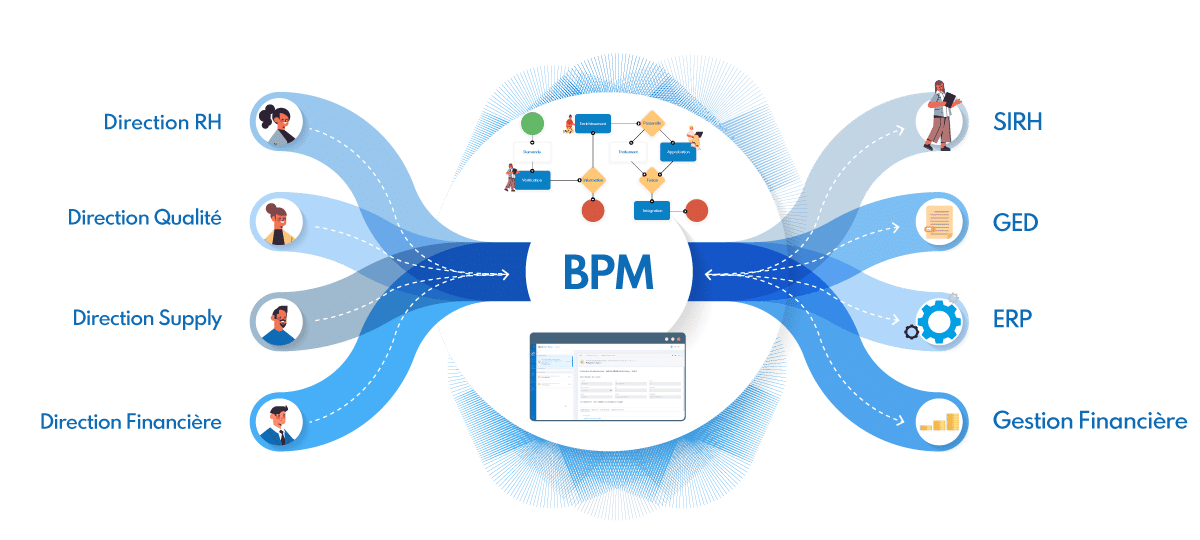Process governance: ensuring that your business processes are aligned with your strategic objectives, and that they are managed effectively and efficiently.
This content on process governance is part of our dossier on BPM (Business Process Management).
Process governance refers to all the structures, roles, responsibilities and practices put in place to establish a clear and coherent vision of the business processes implemented within an organisation. It defines standards and best practices for modelling, implementing, monitoring and improving these processes with the help of tools and technologies that support this management. This governance also aims to put in place measures (KPIs) and reporting to monitor performance and ensure the continuous improvement of these processes. And as with all projects involving the organisation of work, transparency and communication between all stakeholders, particularly the business departments, will be a decisive factor in success and will greatly facilitate the implementation of process governance.
Even today, many Information Systems are still too unstructured:The coexistence of old and new applications communicating on a point-to-point basis: this mode of operation is no longer an option, given the diversity of information sources used by businesses.
This lack of structure has technical, organisational and strategic consequences: it leads to tedious error handling for each business application, wasting precious time for business teams and the Information Systems Department. Teams are thus mobilised on maintenance and error correction instead of being able to concentrate on innovative projects. What's more, the data is collected incompletely, which hampers the cross-referencing of information and the decision-making process.
Il n’est pas superflu de le répéter : la bonne intégration des données est la première étape pour exploiter celles-ci correctement ! Les données sont à la fois au cœur des échanges et des processus de l’entreprise, leur qualité est donc un sujet capital.
Faulty integration within the IS is one of the causes of loss of data integrity. A loss of integrity occurs when the accuracy, completeness or consistency of data is compromised, calling into question its reliability and value. While there are of course other causes, such as system failures, malicious manipulation or data entry errors, poor orchestration of information exchanges within the Information System is one of the main sources! Read the full article: What are the main points of attention and best practices for ensuring the integrity of your data?
As part of a network of specialist garden centres, we implemented the Phoenix platform to enable them to adapt to a high rate of parallel projects within their information system:
At a pharmaceutical laboratory, our teams helped the company gain agility in the development of its information system components:
A specialist DIY chain uses Blueway to manage data input and output with SAP
Process governance boosts the performance of business processes, in particular by identifying and eliminating inefficiencies, and automating certain manual tasks. It also boosts innovation by creating a culture that encourages continuous process improvement, and provides employees with the resources they really need. Process governance is therefore a key success factor for business process management (BPM).
Improve the effectiveness and efficiency of processes.
Reduce operating costs.
Improving the quality of products and services.
Improve business agility and responsiveness.
Ensuring compliance with regulations and standards.
The first step is to clearly define the objectives of this governance, aligning them with the organisation’s strategic objectives. This means identifying those responsible for and involved in these processes: Business Process Owner, Business Process Manager, not forgetting the IT Department and its role as Business Process Architect. Next comes the implementation of BPM tools to model the processes, visually and clearly, in particular using the BPMN 2.0 standard and forms.
Process governance aims to optimise the management of business processes. This means moving away from Excel during the consolidation and information-sharing stages, with all intermediate stages and all data entry carried out in HMIs (Human Machine Interface) using forms and a BPM (Business Process Management) approach. This is the key to implementing a structured, consistent and cross-functional approach to managing business workflows.
It is up to the IT Department to ensure the digitisation of processes, which must take into account the environments of each business line… while guaranteeing interoperability with the Information System. The IT Department therefore has the onerous task of creating a new software architecture, based on the concepts of Service Oriented Architecture (SOA). It has to work with the Business Process Management methodology and implement it with an integrated BPM, MDM and ESB software solution. It’s a real Business Process Manager role!

The Process Governance module of Blueway’s Phoenix process and data integration platform, which makes full use of the BPMN 2.0 standard, enables you to share a common representation of processes within your organisation! Roles, participants, stages, activities and actions are all defined within an intuitive, visual interface. Process Governance enables you to create process governance in compliance with the BPMN 2.0 standard, starting with modelling, and to easily make the link between the idea and its realisation in terms of an IT workflow, through the precise definition of the steps, actions, roles, data and applications involved.

ergonomic and intuitive workflows.
in a collaborative manner between the various stakeholders and teams.
and export BPMN workflow models.
workflows into sub-processes.
Screen generation in Phoenix is 100% visual and intuitive.
At Blueway, we are convinced of the importance of end-to-end business process governance. That’s because it’s what makes data consolidation possible, combining data from several different sources into a single, consistent set of data. This is one of the reasons why our modular Phoenix platform orchestrates both technical and hybrid processes, and guarantees compliance with business rules within these processes (management of sequences, alerts and information routing rules) according to predefined management rules or dynamic rules. What’s more, to speed things up even further, the Phoenix platform includes several pre-configured process models.
Make an appointment now for an exchange or a demo!
Process governance uses data platforms to centralise, manage and analyse the data needed to manage processes, ensuring that decisions are based on reliable, up-to-date data.
It is crucial to ensuring that the data used in business processes is accurate, reliable and secure, and that processes are carried out consistently and in compliance with regulations.
It improves data quality by putting in place policies and procedures for data collection, cleansing, validation and management, ensuring that only accurate and consistent data is used in business processes.